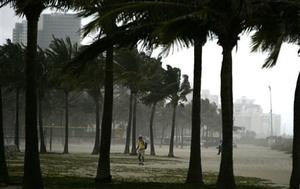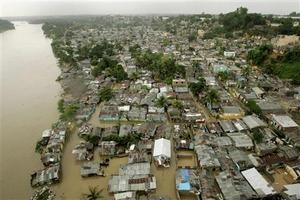
|
| ©REUTERS/Carlos Barria |
| A resident walks on an empty beach in South Beach, Miami as Tropical Storm Noel moves close to the south of Florida October 30, 2007. |
The center of Noel was about 810 miles west-southwest of Bermuda by 8 p.m. EDT and its maximum sustained winds had reached near 75 miles per hour, the U.S. National Hurricane Center said.
Noel is now a Category 1 hurricane, the lowest level on the Saffir/Simpson scale.
A hurricane watch was in effect for the northwestern Bahamas as Noel moved farther away on a long-anticipated shift to the north-northeast that would eventually bring it as a possibly fierce but nontropical storm to Nova Scotia, Canada.
A tropical storm warning remained in effect for the central Bahamas, but the hurricane center said the watch and warning would likely be discontinued on Thursday night.
The British mid-Atlantic territory of Bermuda posted a gale warning, just in case Noel veered more to the east than forecast, U.S. hurricane forecasters said.
The center of Noel was 115 miles north-northeast of Nassau, Bahamas, and was moving north-northeast at a brisk 17 mph, the hurricane center said. The storm's speed was expected to increase over the next 24 hours.
The storm is expected to douse eastern Cuba with another 1 to 2 inches of rain, and North Carolina's Outer Banks could receive an inch.
TRAIL OF DESTRUCTION
The northernmost islands of the Bahamas were still feeling Noel's onslaught on Thursday and several churches opened as shelters on the island of Abaco.
"We are laying on food and the people are bedding down on the floors of the churches," Red Cross volunteer Barbara Johnson said.
Residents of Long Island in the central Bahamas suffered "devastating" losses as the storm dumped a record 15 inches (38 cm) of rain on the island over two days, the National Emergency Management Agency said. The storm caused flood levels on the island not seen for 60 years and families at several settlements were forced to evacuate homes and businesses as water reached a depth of 3 feet in some places.
The storm left a trail of waterlogged death and destruction in the Caribbean after slamming the Dominican Republic, Haiti and Cuba with unrelenting downpours.

|
| ©REUTERS/ Eduardo Munoz |
| Floodwaters partially submerge the neighbourhood of Capotillo after four days of heavy rains in Santo Domingo October 31, 2007. |
At least 73 people died in the Dominican Republic, many of them swept away in muddy floodwaters after two rivers burst their banks and tore through the village of Villa Altagracia outside Santo Domingo.
Thirty-four people were confirmed killed in Haiti, which shares the island of Hispaniola with the Dominican Republic, said Alta Jean-Baptiste, head of the civil protection service.
In Jamaica, one person died when a house collapsed because of heavy rain.
In Cuba, thousands were evacuated from vulnerable areas and reservoirs overflowed, but no deaths were reported.
U.S. forecasters projected the 14th named storm of the 2007 Atlantic storm season would quickly lose its tropical characteristics as it sped to the northeast toward Nova Scotia with powerful extratropical winds.
(Additional reporting by John Marquis in Nassau and Manuel Jimenez in Santo Domingo)



Reader Comments
to our Newsletter